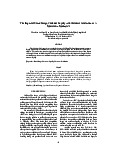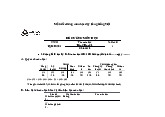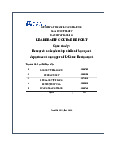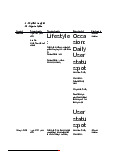



Preview text:
Our culture, the very essence of who we are, is the foundation of our desires and decisions. It
provides a lens through which we see the world.
Deep Rooted: From childhood, we’re steeped in customs, rituals, and traditions that mold our preferences.
Example: In Mediterranean countries, olive oil is a staple, not just because of its taste, but due to its
cultural significance in cooking, religious rituals, and even medicine. Contrast this with soy sauce in
East Asian countries, deeply embedded in culinary traditions." Subcultures
"While culture gives us a broad umbrella, subcultures fine-tune our preferences. These are smaller
groups within a culture, often sharing unique beliefs or experiences.
Age, Ethnicity, Region: Subcultures can form based on age groups, ethnic backgrounds, or regional differences.
Example: Take the U.S., where the South has a unique affinity for sweet tea, an identity distinctly
different from the coffee-loving Northwest. Likewise, Hispanic Americans might have a preference for
spices and flavors distinct from their non-Hispanic counterparts." Social Class
"Each society subtly segments itself, often based on resources, education, or occupation. These
segments, or social classes, have distinct preferences.
Nuances: It’s not just about money; it's also about nuances in tastes, values, and behaviors.
Example: The choice between buying a handbag can vary widely. A working-class individual might
look for durability and price efficiency, opting for a sturdy leather bag. In contrast, someone from the
upper class might lean toward luxury brands like Gucci or Louis Vuitton, not just for quality, but for
the status symbol it represents." Slide: Reference Groups
Definition: "Reference groups are those that have a direct or indirect influence on our attitudes or
behaviors. They serve as a point of reference in forming our own behaviors and decisions."
Influences:Comparative Importance: "We often compare our choices with those of reference groups to affirm our decisions."
Direct Interaction: "Groups we interact with directly, like friends or colleagues, heavily impact our daily choices." Examples:
"Teenagers may want a specific sneaker brand because their friends, a key reference group, all wear it."
"A professional might join a particular gym or club because colleagues, another significant reference group, recommend it." Slide: Family
Definition: "The family is arguably the most influential primary reference group. From our early years
and beyond, family members shape our values, preferences, and behaviors." Influences:
Childhood Imprint: "Preferences formed during childhood, influenced by our parents, often carry on into adulthood."
Spousal Impact: "In many families, spouses significantly influence each other's buying decisions." Examples:
"A preference for a particular brand of detergent might stem from what our parents used."
"A husband might choose a restaurant for an anniversary date based on his wife's known preferences." Slide: Roles and Status
Definition: "Within each of our social groups, be it family, work, or recreational, we play distinct
roles, each coming with its own set of expected behaviors and status." Influences:
Role-based Behavior: "The decisions we make are often aligned with the roles we play. A father
might prioritize safety in a car, while a manager might look for efficiency in a new software."
Status Symbols: "Certain products or brands are used as symbols to signify a particular status in society." Examples:
"A university dean might prefer formal attire, aligning with the dignity and status of her role."
"A luxury watch or an upscale car can often be more about signaling status than just personal preference."
Slide: Age and Life Cycle Stage
Definition: "As we journey through life, our tastes, preferences, and needs evolve based on our age and life's milestones." Influences:
Evolving Needs: "From baby products to retirement plans, our requirements shift dramatically throughout our lives."
Life Events Impact: "Events like graduation, marriage, or childbirth bring about specific consumer needs." Examples:
"A college student might prioritize buying textbooks and instant noodles, while newlyweds may invest in home appliances."
"Upon retirement, there's a likely shift towards health products and travel experiences." Slide: Occupation
Definition: "Our jobs and professions significantly influence the products we buy and the brands we prefer." Influences:
Job Requirements: "Certain jobs necessitate specific products or services."
Professional Image: "Many aim to maintain a particular image or standard in line with their profession." Examples:
"An artist might spend more on high-quality brushes and canvases, while a banker might invest in formal wear."
"A software developer might prioritize a high-performance computer, while a fitness instructor might invest in sportswear." Slide: Economic Situation
Definition: "Financial stability and economic outlook play a pivotal role in our buying decisions." Influences:
Budget Constraints: "Not everyone can afford everything; we often prioritize based on our financial standing."
Future Financial Expectations: "Economic forecasts can also influence spending behaviors." Examples:
"During economic downturns, families might cut down on luxury items and prioritize essentials."
"On receiving a bonus or promotion, an individual might splurge on a long-desired luxury item." Slide: Lifestyle
Definition: "Lifestyle encompasses our interests, activities, and opinions. It’s a reflection of 'how we
live our lives' and significantly shapes our buying patterns." Influences:
Hobbies & Interests: "Our pastimes and passions often drive specific product or brand choices."
Life Choices: "Values such as sustainability can influence preference for eco-friendly products." Examples:
"A yoga enthusiast might spend on organic food and wellness retreats."
"An avid traveler may prioritize durable luggage and travel insurance."
Slide: Personality and Self-Concept
Definition: "Our personality traits, whether we're introverted or extroverted, adventurous or
conservative, play a part in our consumer choices." Influences:
Self-Perception: "How we view ourselves often resonates with the brands or products we align with."
Desire for Consistency: "We prefer brands that mirror our self-concept." Examples:
"Someone with a bold personality might choose vibrant clothing or a standout car model."
"An individual who perceives themselves as sophisticated might prefer luxury brands and upscale experiences."




